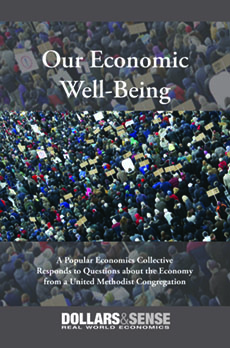Our Economic Well-Being
In 2014, members of the congregation of the Bay Ridge United Methodist Church took out a half-page ad in the New York Times, posing a question and a challenge—how can we explain changes in economic well-being in the United States, especially the broad differences between the post-World War II era, f

Edition:1st
Date of publication:April 2017
ISBN:978-1-939402-29-5
Pages:192
Price:$24.95
Email us for information about bulk-order discounts for activist groups, church groups, and unions!
In 2014, members of the congregation of the Bay Ridge United Methodist Church took out a half-page ad in the New York Times, posing a question and a challenge—how can we explain changes in economic well-being in the United States, especially the broad differences between the post-World War II era, from the late 1940s to the early 1970s, compared to the era since the early ‘70s? The congregation offered an “Economic Well-Being Award” to “an economist, or group of economists, who identify the factors associated with the stronger economy in the period from 1946 to 1971, and the factors associated with the weaker economy in the period from 1972 to 2012. (Find the church's webpage about the award here.)
This new edited volume is a response to this question from the editorial collective of Dollars & Sense. (Profiles of the BRUMC congregation and the D&S collective were the basis of Church Economics Prize, the February 13, 2015, episode of the PBS program “Religion and Ethics Newsweekly.”)
It’s absolutely clear that the congregation’s question—why the economy doesn’t seem to work as well for (at least many) ordinary people as it once did—is among the most urgent questions in the United States today. In the course of the 2016 presidential election campaign, the message that the economy had been “rigged,” serving only a small group of wealthy and powerful people, resonated with millions. That should not be surprising, after decades of wage stagnation, rising income inequality, declining job security, and increasing personal debt.
It’s imperative, first, to come up with answers to the congregation’s question, diagnosing how the U.S. economy took its current form, and how that differs from what we would want. We can believe that there are, indeed, very serious problems with the U.S. economy, while rejecting the idea that immigration, social welfare programs, labor unions, regulation of business, or excessive taxes on the “job creators” are the sources of the problems.
Second, it’s necessary to come up with solutions—to the multiple problems we confront—that are rooted in a spirit of solidarity and compassion for each other, across lines of race and ethnicity, nationality and immigration status, gender and sexuality. As the BRUMC congregation put it in its initial letter, we must strive to promote “civil liberty and economic justice, for all.” This means that our answers to current grievances must reject the scapegoating of the marginalized, disenfranchised, and downtrodden, and instead seek solutions consistent with the admonition, from the gospels, to “love thy neighbor as thyself.”
Pre-order your copy today. Bulk discounts for church groups, community groups, and unions.
- The Economic Well-Being Award
- Introduction: From Our Collective to Your Congregation
- Chapter 1: Measuring Our Economic Experience
- 1. Are We Better Off Than We Were Forty Years Ago?Zoe Sherman
- 2. The Real Unemployment RateJohn Miller
- 3. Our Triple Jobs ProblemAlejandro Reuss
- 4. The Gig EconomyGerald Friedman
- 5. What Happened to Wages?Gerald Friedman
- 6. Myths of the DeficitMarty Wolfson
- 7. Myths and Realities of Government SpendingGerald Friedman
- 8. The Great Tax-Cut ExperimentGerald Friedman
- 9. GDP and Its DiscontentsAlejandro Reuss
- 10. Beyond Debt and GrowthAn Interview with Robert Pollin
- 11. The Costs of AusterityGerald Friedman
- 12. What Happened to the Recovery?Gerald Friedman
- Chapter 2: We Had Choices: What Choices Did We Make That Got Us Here?
- 1. That ’70s CrisisAlejandro Reuss
- 2. Inequality, Power, and IdeologyArthur MacEwan
- 3. A Great Fall: The Origins and Crisis of NeoliberalismDavid M. Kotz
- 4. All the King’s Horses: Neoliberal Capitalism, Its Crisis, and What Comes NextDavid M. Kotz
- Chapter 3: We Still Have Choices. How Can We Change Course?
- 1. Rank-and-File EconomicsKatherine Sciacchitano
- 2. Universal Health Care: Can We Afford Anything Less?Gerald Friedman
- 3. What Would Full Employment Cost?Arthur MacEwan
- 4. We Need a (Green) Jobs ProgramJeannette Wicks-Lim
- 5. A Superfund for WorkersJeremy Brecher
- 6. Equal Treatment for ImmigrantsAlejandro Reuss
- 7. Why We All Need Affirmative ActionJeannette Wicks-Lim
- 8. “Just Cause” and the Attack on Job SecurityRand Wilson
- 9. A Case for Public OwnershipArthur MacEwan
- 10. Co-op EconomicsNancy Folbre
- 11. Climate Policy as Wealth CreationJames K. Boyce
- 12. Escaping the Dependency Trap of CapitalismCynthia Kaufman
- 13. The Future of Work, Leisure, and ConsumptionAn Interview with Juliet Schor
- Appendix: Trumpism: Causes and Consequences
- 1. Trump and National NeoliberalismSasha Breger Bush
- 2. It Can Happen HereDavid M. Kotz
- 3. Making America Irate AgainSteven Pressman
- 4. What Trump Can and Can’t Do to ImmigrantsDavid Bacon
- 5. Three Wages of WhitenessZoe Sherman
- 6. Surviving in the Age of TrumpDean Baker
- 7. Green-State AmericaFrank Ackerman
- Contributors
